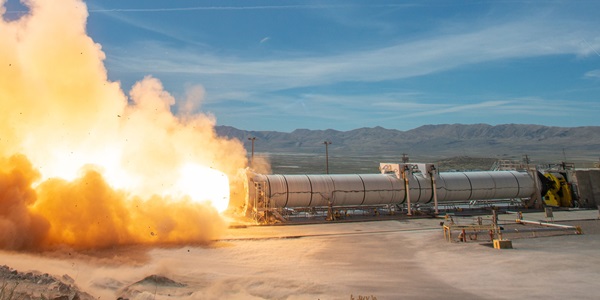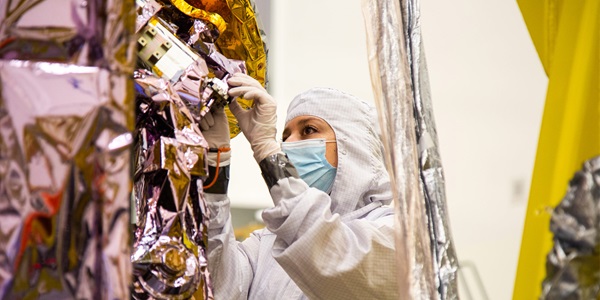Beyond the Boneyard: STEM Education and More

By Rick Robinson
What happens to aerospace vehicles and components when the programs they were built for wind down and come to a close? In the old days, they ended up
in the boneyard — baking in the desert sun on the outskirts of a Western airfield, waiting to be scrapped.
That was then. Today, Northrop Grumman has taken the lead in finding creative solutions to end-of-life management, the process of gaining additional value from retired equipment. From STEM education to technician training and public display, Northrop Grumman is demonstrating that there is still plenty of life in end-of-life technology.

The Original Recoverable Boosters
One unique example of end-of-life management is surplus solid rocket boosters (SRBs) that lofted the Space Shuttle into orbit from the 1980s to the 2010s. Recovering space boosters for refurbishment and re-use is sometimes described as the latest new thing, but in fact, Northrop Grumman and its predecessors have been doing it for decades.
SRB components that took part in 82 Shuttle flights during its generation of service have now been assembled into two complete (though safely inert) SRBs that will be displayed in upright launch configuration for the public at the California Science Center in Los Angeles.

Ongoing Evolution of a Technology
The SRB technology from the Shuttle program remains very much alive — incorporated into NASA's Space Launch System (SLS) heavy-lift booster, the centerpiece of the Artemis program that will return Americans to the moon and establish a base there.
Charlie Burt, program manager for the SLS dealing with Pressurized Structures (also called Case Structures), outlines the ongoing history of the technology and some of its distinctive features. In simplest terms, the SRBs are strongly built cylinders filled with solid rocket propellant. They are called pressurized structures because they must stand up to the enormous internal pressure generated by a million and a half pounds of thrust.
Because of their enormous size, SRBs are not built as a single unit but as a series of cylinders that are fitted together like lengths of pipe. Between flights, they were dismantled to be refurbished and refueled, then joined back together. Like rail train cars, they were (and are) not always re-connected to the same segments they flew with last time. Instead, during rocket motor assembly, the mission planners would use whichever necessary components were available through the refurbishment process.

A Hands-on STEM Education
As Burt emphasizes, the process of reassembling segments into a complete SRB is a delicate and highly skilled task. This is where STEM education comes into the picture.
Amid a heavy schedule of ongoing development work at Northrop Grumman's Utah test facility, prepping the donated SRB segments for transport to California called for some creative workarounds. Because the static test installations normally used for assembly were booked up with new projects, the donated segments were instead rejoined in a facility called the Large Motor Casting Pit, normally used for filling the SRB structure with the solid rocket fuel that will launch it into space.
The donated SRBs contain no rocket fuel and are thus much safer to work with than fueled SRBs. But the reassembly process is just as demanding and delicate — and an ideal training environment for a new generation of technicians to learn the skills and techniques they will need to prep SLS boosters for upcoming Artemis missions.
As Charlie Burt describes this process, he also provides a quick education in the subtleties of space development terminology. The technicians who assemble the SRBs are operators in the specialized language of quality control. And in speaking of the ongoing evolution of space technology, Burt makes a careful distinction between verification and development and, alternately, qualification — a term that, to the professionals, connotes a later stage of a program that is starting to move toward the launch pad.
As for the donated SRBs, they will be incorporated into one of only two exhibits nationwide that will display Shuttles in their launch configuration. There, they will perform their final mission of inspiring a new generation of space scientists, engineers and explorers.
More innovation stories
Read all stories about advanced technology and innovation >>


